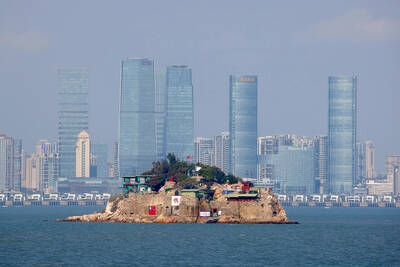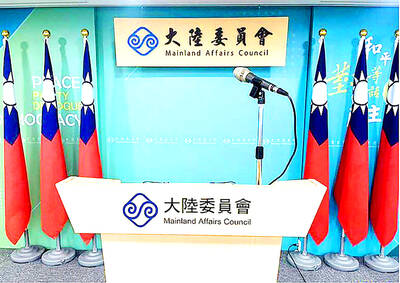When friends of Liu Yueh-shan (劉玥珊), an employee of an electronics firm in Taichung, heard that she had just returned from a trip to Green Island (綠島), they were eager to find out if she had gone snorkeling or tried the hot springs on the island’s northeast coast.
“I would always tell them that ‘I wasn’t going there for fun,’” Liu wrote in her online journal. “I told them I was there to be in prison, to feel and experience the torture and sufferings that my grandfather had been through.”
Liu knew from her childhood that her grandfather was one of the victims of the 228 Incident and was executed by the Chinese Nationalist Party (KMT) Government in Taipei. The 228 Incident took place in 1947 when Chinese Nationalist troops suppressed a Taiwanese uprising, leaving tens of thousands dead, missing or imprisoned.
Liu, however, was not motivated to take on this root-searching journey until she saw the name of her grandmother, Liu Wan-shan (劉萬山), carved on the 228 Monument in the Taiwan Democracy Memorial Hall in March.
Liu was one of the 40 people who participated in the Prison Experience Camp last month, hosted by the Taiwan 21st Century Cultural Association. Participants stayed in prison cells at the Eastern Coastal Patrol Office on Green Island for two nights. Aside from spending the night in prison, the association took them to visit the Oasis Village (綠洲山莊), which is now known for once being the home of political prisoners.
Attendees also took part in a question-and-answer session with victims of the White Terror, who were addressed as “freshmen” (新生) back in those days.
The Oasis Village is no longer used as a jail. The history, however, has made Green Island a must-visit tourist attraction for those interested in the nation’s history.
The association’s chief secretary, Chen Yi-shan (陳億珊) said that young people learn many things through the event.
Facilities inside the village, such as the large hexagon prison that housed all the inmates and the administrative office, remain intact. Two years ago, the government decided to establish the Green Island Culture Park (綠島文化園區).
“The 13th Squadron,” (中隊), for example, was a title given to those who died on the island from sickness or accidents. Those of the 13th squadron were buried in a site near the village.
“Hell’s Gate” (鬼門關) is a giant rock near the seaside in the shape of an elephant’s nose. Every newcomer had to enter Oasis Village under the elephant’s nose. The rock was named Hell’s Gate because it led to the unpredictable path of life or death.
Built in 1999, the Human Rights Memorial Park near the Oasis Village has also become part of the culture park. Designed by Taiwanese architect Han Pao-teh (漢寶德), the Memorial Park is known for its Human Rights Monument, the first one in Asia.
On the monument is a verse written by poet Bo Yang (柏楊): “In that era, mothers cried night after night over their children imprisoned on this island.”

The Chinese Communist Party (CCP) is pushing for residents of Kinmen and Lienchiang counties to acquire Chinese ID cards in a bid to “blur national identities,” a source said. The efforts are part of China’s promotion of a “Kinmen-Xiamen twin-city living sphere, including a cross-strait integration pilot zone in China’s Fujian Province,” the source said. “The CCP is already treating residents of these outlying islands as Chinese citizens. It has also intensified its ‘united front’ efforts and infiltration of those islands,” the source said. “There is increasing evidence of espionage in Kinmen, particularly of Taiwanese military personnel being recruited by the

ENTERTAINERS IN CHINA: Taiwanese generally back the government being firm on infiltration and ‘united front’ work,’ the Asia-Pacific Elite Interchange Association said Most people support the government probing Taiwanese entertainers for allegedly “amplifying” the Chinese Communist Party’s propaganda, a survey conducted by the Asia-Pacific Elite Interchange Association showed on Friday. Public support stood at 56.4 percent for action by the Mainland Affairs Council and the Ministry of Culture to enhance scrutiny on Taiwanese performers and artists who have developed careers in China while allegedly adhering to the narrative of Beijing’s propaganda that denigrates or harms Taiwanese sovereignty, the poll showed. Thirty-three percent did not support the action, it showed. The poll showed that 51.5 percent of respondents supported the government’s investigation into Taiwanese who have

Left-Handed Girl (左撇子女孩), a film by Taiwanese director Tsou Shih-ching (鄒時擎) and cowritten by Oscar-winning director Sean Baker, won the Gan Foundation Award for Distribution at the Cannes Critics’ Week on Wednesday. The award, which includes a 20,000 euro (US$22,656) prize, is intended to support the French release of a first or second feature film by a new director. According to Critics’ Week, the prize would go to the film’s French distributor, Le Pacte. "A melodrama full of twists and turns, Left-Handed Girl retraces the daily life of a single mother and her two daughters in Taipei, combining the irresistible charm of

South Korean K-pop girl group Blackpink are to make Kaohsiung the first stop on their Asia tour when they perform at Kaohsiung National Stadium on Oct. 18 and 19, the event organizer said yesterday. The upcoming performances will also make Blackpink the first girl group ever to perform twice at the stadium. It will be the group’s third visit to Taiwan to stage a concert. The last time Blackpink held a concert in the city was in March 2023. Their first concert in Taiwan was on March 3, 2019, at NTSU Arena (Linkou Arena). The group’s 2022-2023 “Born Pink” tour set a